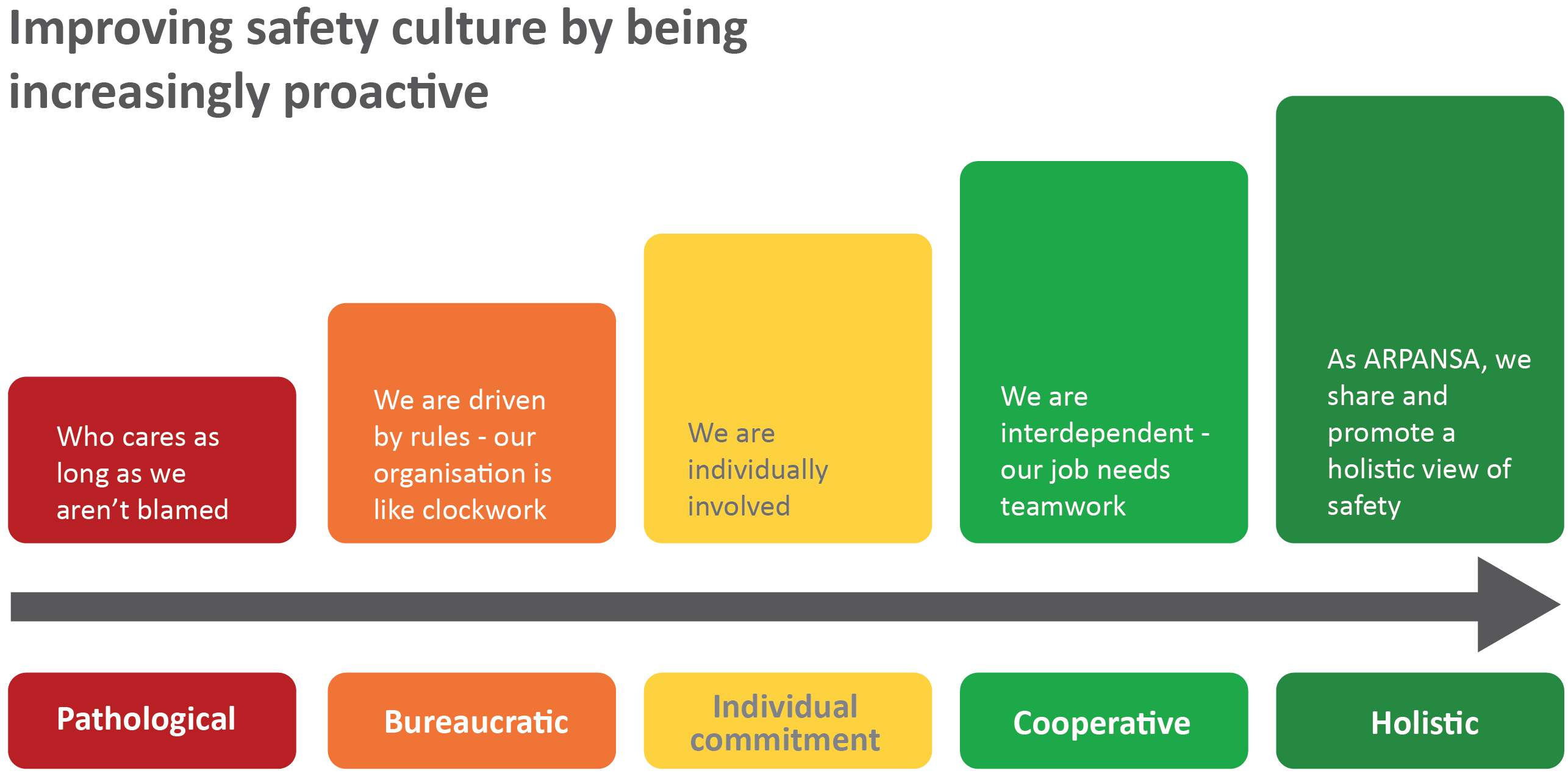Safety culture is about the core values, beliefs and behaviours that an organisation holds and how they affect safety. See holistic safety for further information on the concept of safety culture.
Our safety culture affects the safety and wellbeing of our staff and how we conduct our services, the values we convey and the relationships we develop. Our work has an impact for the safety of the Australian community through the controls we administer and the influence we exert.
Having an objective understanding of safety culture is important for ARPANSA and all organisations. The process of understanding safety culture is challenging and sometimes confronting. It can sweep away perceptions that ‘all is well’ or highlight some issues that were known only to some workgroups.
An assessment should bring together people to discuss matters that impact safety, and this can lead to significant improvements.
The assessment of safety culture is seen as best practice. The United Nations' International Atomic Energy Agency (IAEA) has embedded the requirement to undertake safety culture assessments into its standards. Requirement 14 of IAEA General Safety Requirements Part 2 states that ‘senior management shall regularly commission assessments of leadership for safety and of safety culture in its own organisation’. The IAEA provides guidance on its preferred method of assessment in Safety Report Series No.83 – Performing Safety Culture Self-assessments.
Safety culture assessment at ARPANSA
There are a number of methods available to assess safety culture. ARPANSA has developed a custom safety culture maturity model and used it to conduct a study of the safety culture initially of its regulatory services branch and then of the whole organisation. The model draws on the Nuclear Energy Agency's The Safety Culture of an Effective Nuclear Regulatory Body and involves the collection of data through surveys, focus groups, interviews, workplace observations and document reviews. Maturity is assessed for five elements:
- Leadership for safety
- Individual responsibility and accountability
- Safety oversight and systemic approach
- Collaboration and open communication
- Continuous improvement and self-assessment
For each element, the results are reported on a five point scale from pathological to holistic.

Safety culture assessment - 2023
In 2023, ARPANSA conducted its second agency-wide Safety Culture Assessment (SCA), demonstrating its continued effort in aligning with international best-practice and guidance from the International Atomic Energy Agency (IAEA). This assessment sought to provide ARPANSA with insights into its current safety culture, develop a vision for its future, and determine practical steps for maintaining and improving safety.
The 2023 SCA adopted a more holistic methodological approach than past assessments. This update enabled a more robust appraisal of the agency’s safety culture but makes it difficult to compare the results of this assessment with those of 2019. Future assessments at ARPANSA will use the 2023 methodology to enable comparisons over time.
Results from the 2023 SCA showed that safety culture at ARPANSA sits mostly at a middling level of maturity, with 4 out of 5 topics rated at the “individual” level. Action plans based on these outcomes have been developed to guide next steps and meet ARPANSA’s vision for the future.
Downloads
2023 Safety culture assessment - whole of agency
Safety culture assessment - 2019
Between January and March 2019, ARPANSA conducted a pilot safety culture assessment of its regulatory functions and then developed an action plan based on the outcomes. This was followed, in October 2019, by a wider assessment of the whole organisation. Implementation of a whole of agency safety culture action is in development. The assessments were undertaken by a small team with external support from SafetyWorks.
The results showed an overall positive safety culture ranging in maturity from ‘individual commitment’ to ‘cooperative’ levels. The process was a valuable exercise for ARPANSA, with staff feedback indicating that the initiative brought people together and improved appreciation and understanding of safety. These assessments mark the first of regular assessments that will be undertaken by ARPANSA to review and strengthen its safety culture.
Downloads
Safety culture assessment report - whole of agency
Safety culture assessment report and action plan - Regulatory Services Branch pilot program


